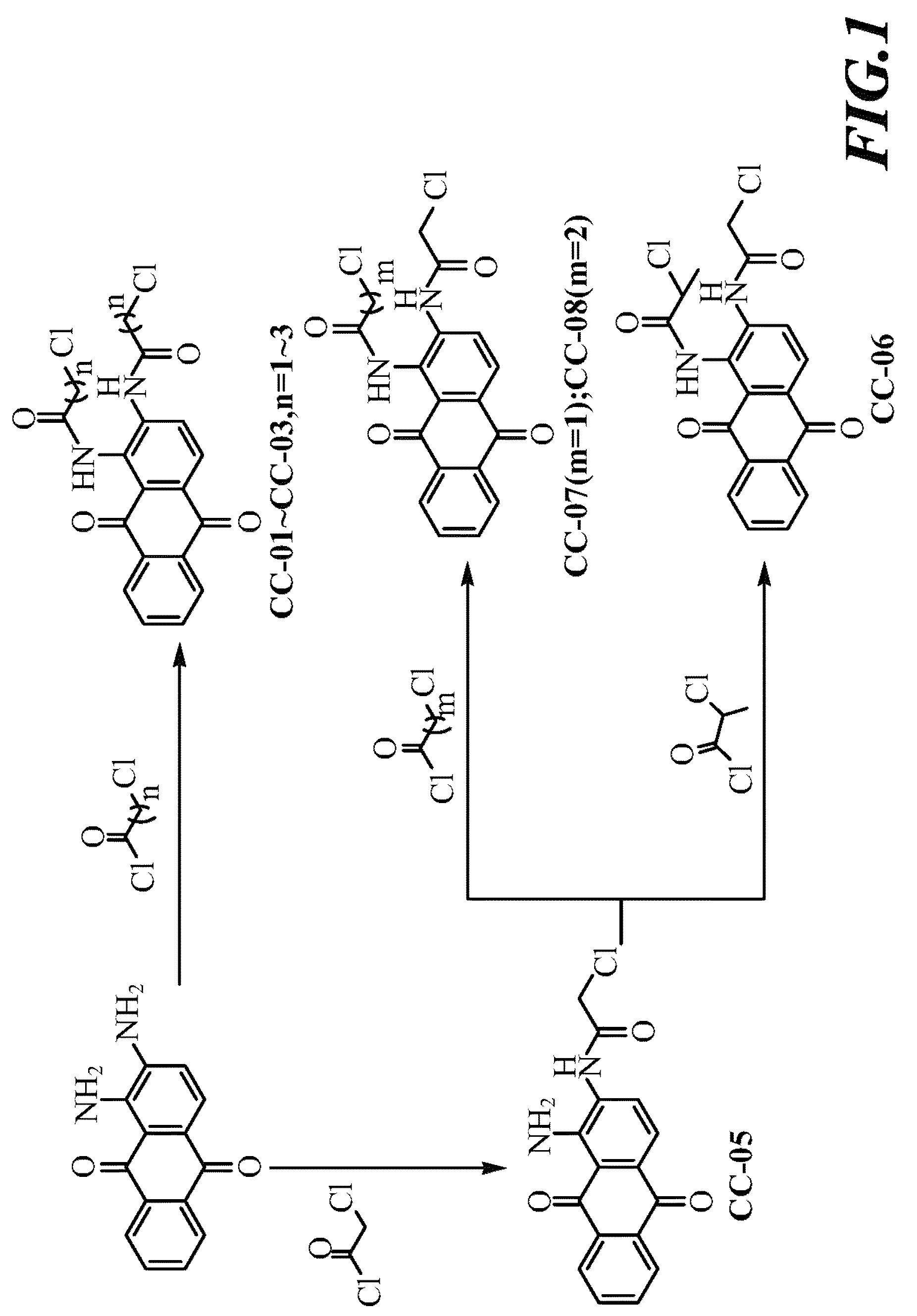1, 2-disubstituted amido-anthraquinone derivatives, preparation method and application thereof
a technology of amido-anthraquinone and derivatives, which is applied in the field of cancer drug development, can solve the problems of telomere length reduction, instability of chromosome, and inability to protect the terminal end of telomer
- Summary
- Abstract
- Description
- Claims
- Application Information
AI Technical Summary
Benefits of technology
Problems solved by technology
Method used
Image
Examples
example 1
Source of Material
From Merck
[0031]TLC 60 F254, methanol, dichloromethane, Chloroform-d1, Dimethyl sulfoxide-d6 99.8%, DMSO-d6.
From Aldrich:
[0032]1,2-diaminoanthraquinone, N,N-Diisopropylethylamine (DIPEA), triethylamine (TEA), pyridine, N,N-dimethylformamide anhdrous 99.8% (DMF), tetrahydrofuran anhdrous 99.9% (THF), chloroacetyl chloride, 3-chloropropionyl chloride, 4-chlorobutyryl chloride, 2-chloropropionyl chloride, 5-chlorovaleroyl chloride, benzoyl chloride, 4-toluoyl chloride, 3-toluoyl chloride, 2-toluoyl chloride, 4-fluorobenzoyl chloride, 3-fluorobenzoyl chloride, 2-fluorobenzoyl chloride, 4-chlorobenzoyl chloride, 3-chlorobenzoyl chloride, 2-chlorobenzoyl chloride, 4-(trifluoromethyl)benzoyl chloride, 3-(trifluoromethyl)benzoyl chloride, 2-(trifluoromethyl)benzoyl chloride, 2,5-(trifluoromethyl)benzoyl chloride, phenylacetyl chloride, cyclopropane carbonyl chloride, cyclohexanecarbonyl chloride, 2-furoyl chloride, 2-thiophenecarbonyl chloride, isoxazole-5-carbonyl chlorid...
example 2
Scheme I, Referring to FIG. 1:
1. General Procedure A
[0035]1,2-diaminoanthraquinone was dissolved in DMF, added thereto successively with pyridine and a series of acyl chlorides under stirring. After completion of reaction, the mixed solution was cooled down, filtered to obtain precipitate and finally, the precipitate was washed with ethanol, then compounds CC-01 to CC-03 can be obtained.
2. General Procedure B
[0036]1,2-diaminoanthraquinone was dissolved in DMF, and added thereto with chloroacetyl chloride under stirring. After completion of reaction, the mixed solution was cooled down, filtered to obtain precipitate, and finally, the precipitate was washed with ethanol, then compounds CC-05 can be obtained.
3. General Procedure C
[0037]Compound CC-05 was dissolved in DMF, and added thereto successively with (1) pyridine and 2-chloropropionyl chloride, (2) pyridine and 3-chloropropionyl chloride, or (3) pyridine and 4-chlorobutyryl chloride under stirring. After comple...
example 3
Telomerase Activity Assays
[0043]Compounds CC-01 to CC-50 (total 50 compounds) chemically synthesized above were subjected to following three sections of telomerase activity assays: 3-1. Telomere repeat amplification protocol (TRAP) assays; 3-2. Secreted alkaline phosphatase assay (SEAP assay) and MTT assay, to assay the cell survival rate of cancer cell; 3-3. The United State National Cancer Institute (NCI) had selected 5 compounds from the invention, which were subjected to cell toxicity assay against 55 to 60 kinds of cancer cell lines.
3-1. Telomere Repeat Amplification Protocol (Trap) Assay:
[0044]Telomerase activity was detected by a modified version of the general TRAP protocol. Telomerase products were resolved by 10% polyacrylamide gel electrophoresis and visualized by staining with SYBER Green. As a source of telomerase, the total cell lysates derived from lung cancer cell line H1299 cells were used. Protein concentration of the lysates was assayed using Bio-Rad protein assay...
PUM
| Property | Measurement | Unit |
|---|---|---|
| temperature | aaaaa | aaaaa |
| drug resistance | aaaaa | aaaaa |
| stability | aaaaa | aaaaa |
Abstract
Description
Claims
Application Information
 Login to View More
Login to View More - R&D
- Intellectual Property
- Life Sciences
- Materials
- Tech Scout
- Unparalleled Data Quality
- Higher Quality Content
- 60% Fewer Hallucinations
Browse by: Latest US Patents, China's latest patents, Technical Efficacy Thesaurus, Application Domain, Technology Topic, Popular Technical Reports.
© 2025 PatSnap. All rights reserved.Legal|Privacy policy|Modern Slavery Act Transparency Statement|Sitemap|About US| Contact US: help@patsnap.com



